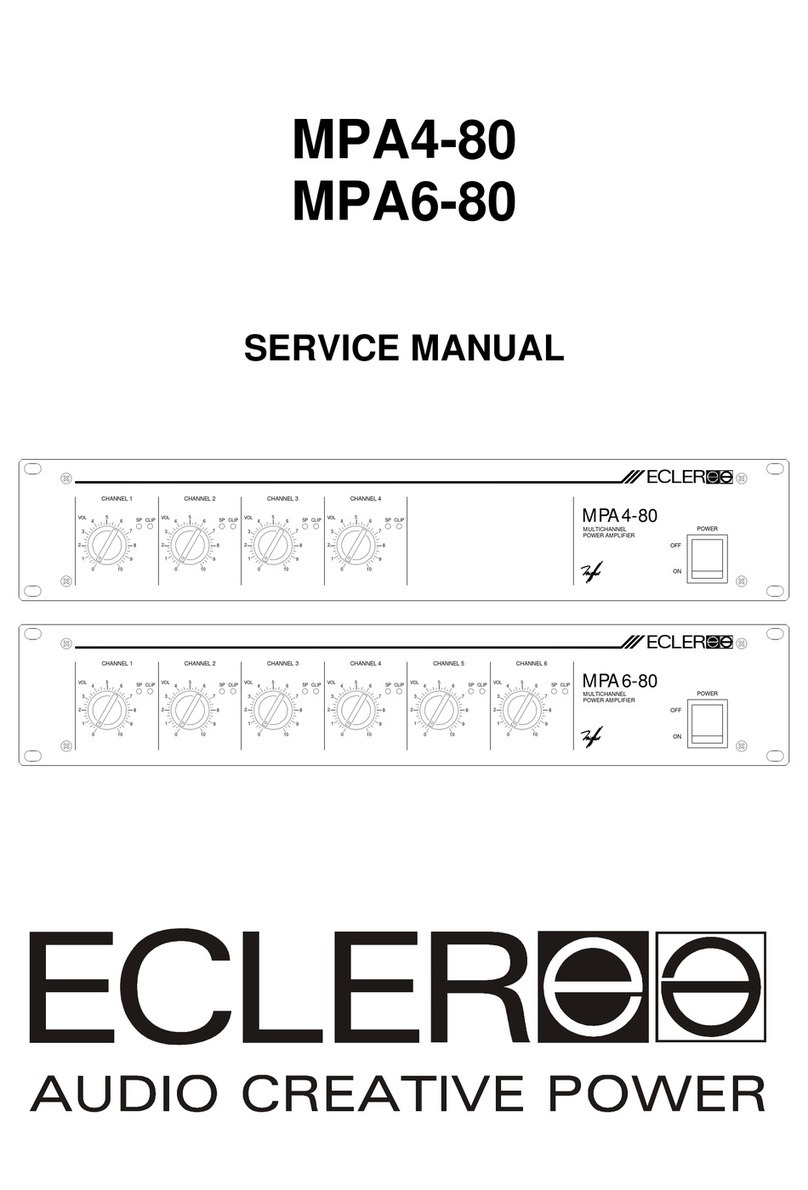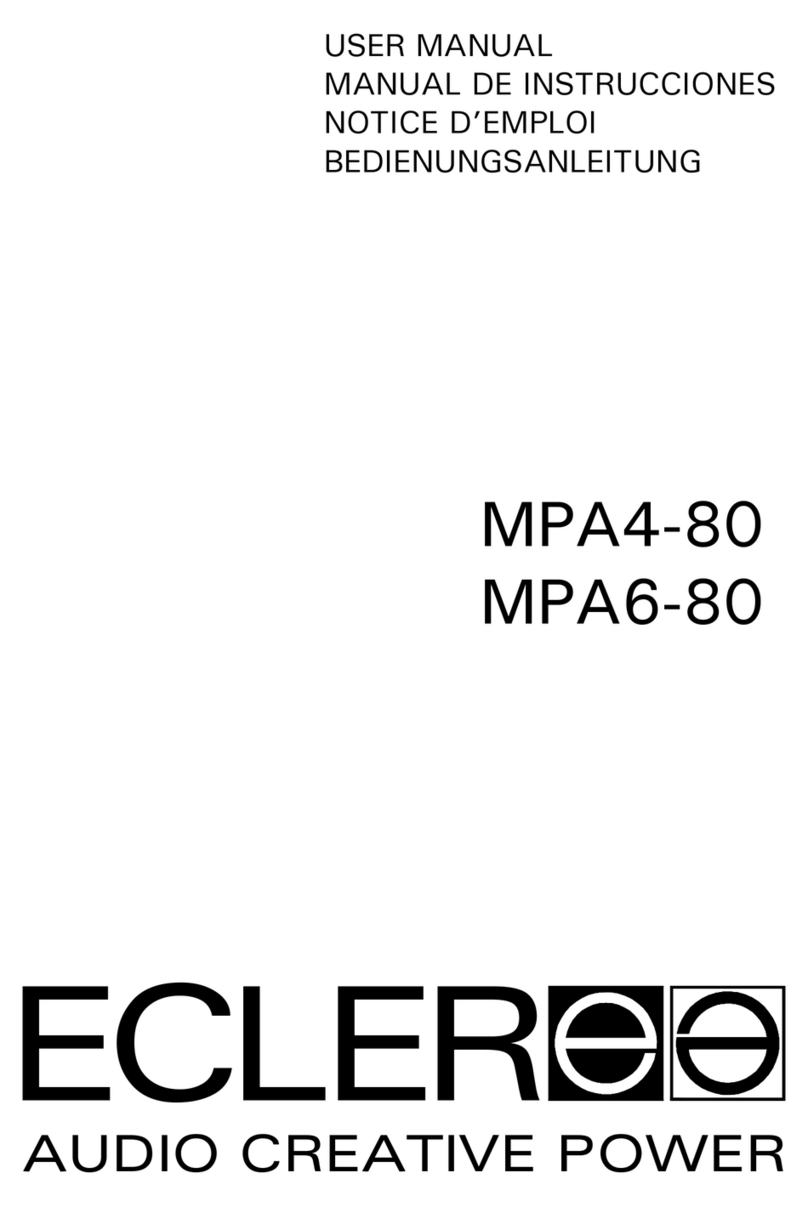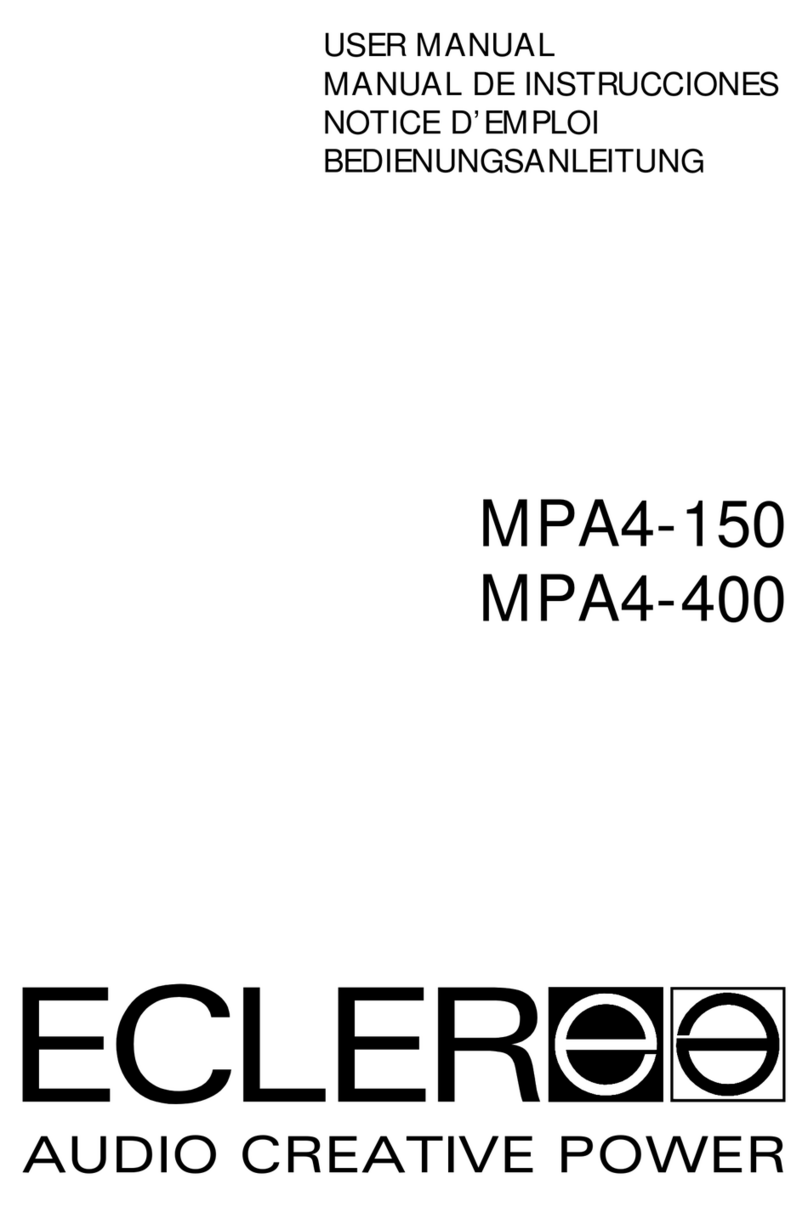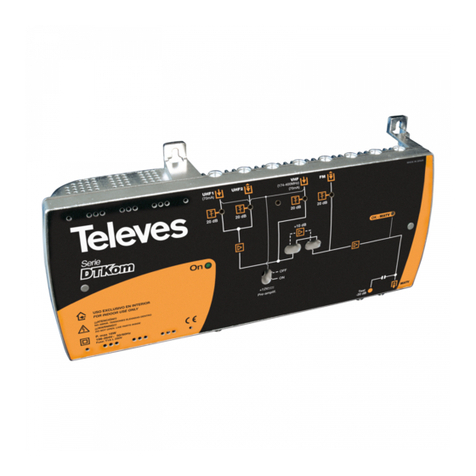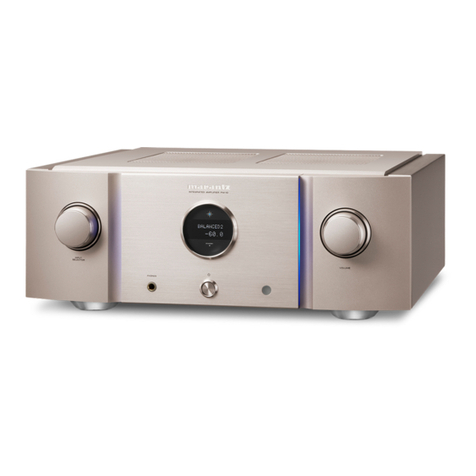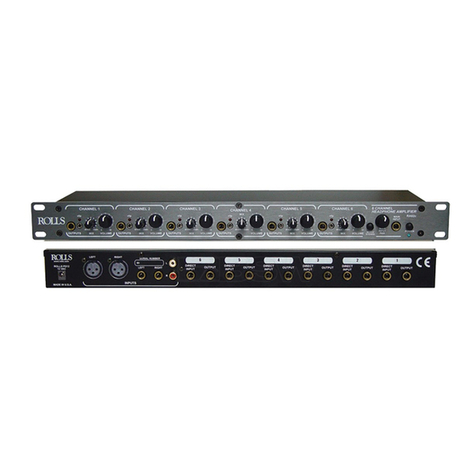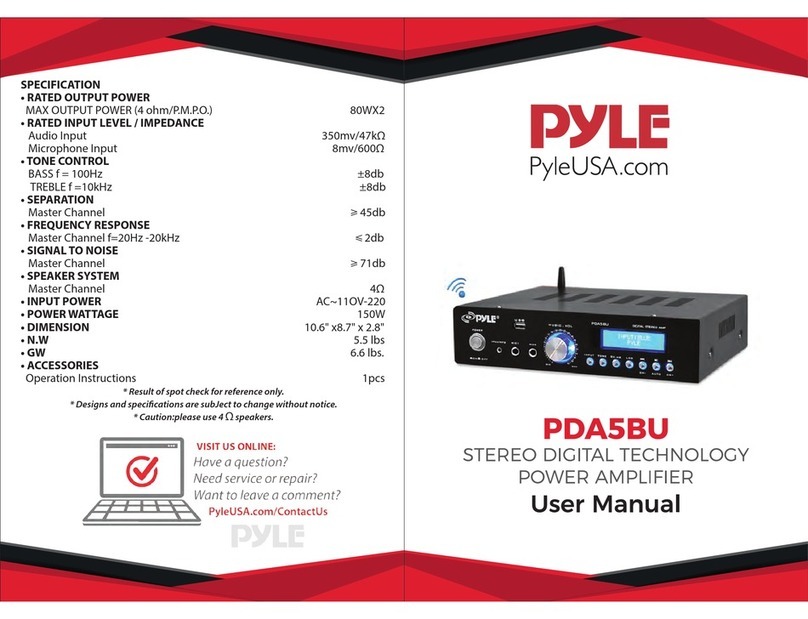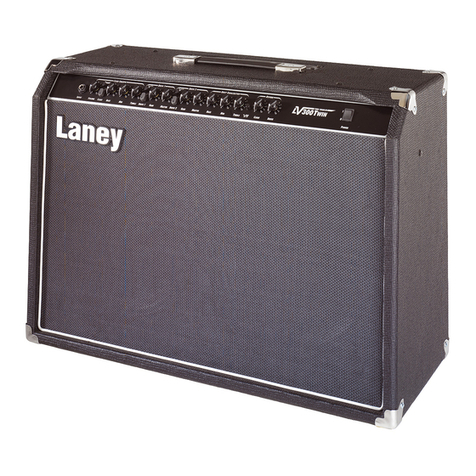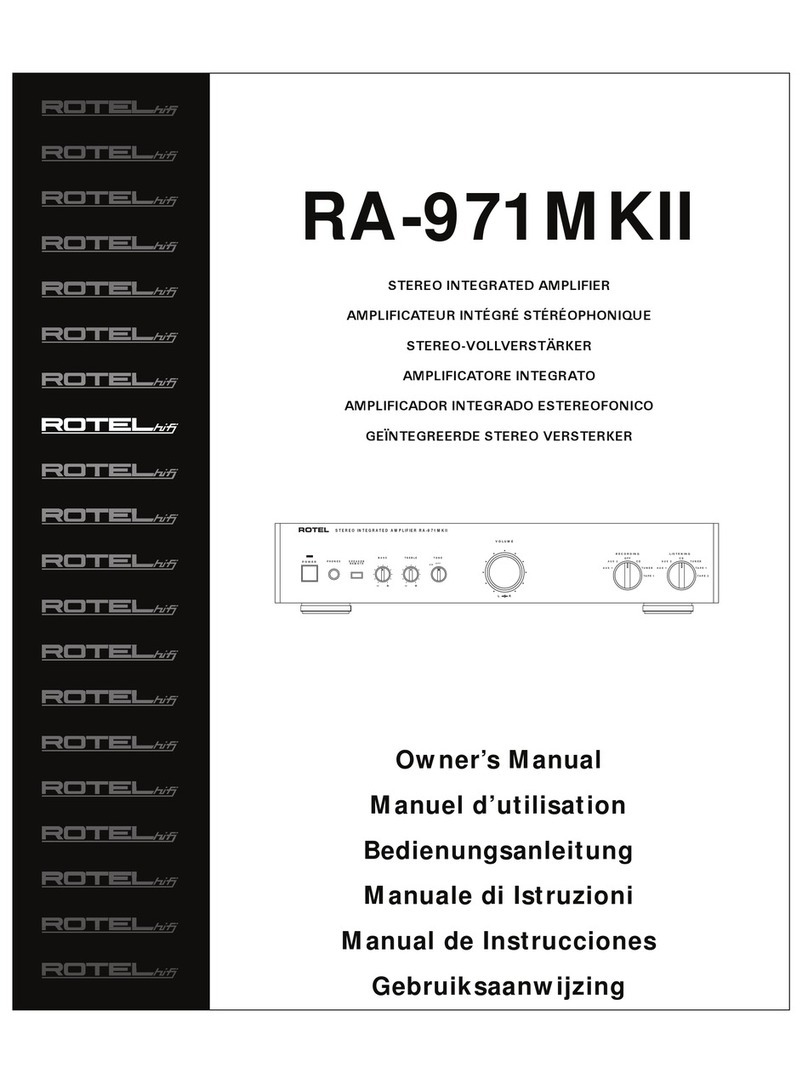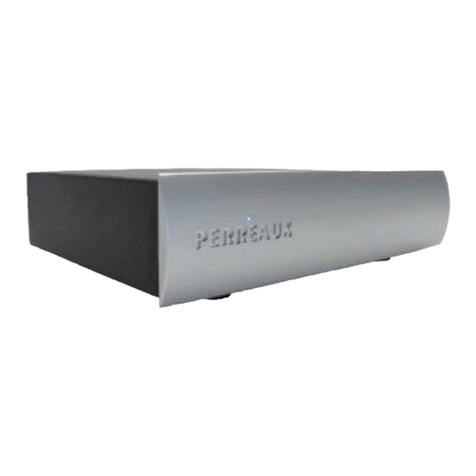Ecleree MPA4-400R User manual

USER MANUAL
MANUAL DE INSTRUCCIONES
NOTICE D'UTILISATION
BEDIENUNGSANLEITUNG

2

3
INSTRUCTION MANUAL
1.IMPORTANTREMARK 04
2. INTRODUCTION 04
3. INSTALLATION 06
3.1. Placement and mounting 06
3.2. Mains connection 06
3.3. Ground Link switch 06
3.4. Multi-function 07
3.5. Input connections 08
3.6. Input options 09
3.7. Limiter circuit 09
3.8. Output connections 10
3.9. Output options 10
4. OPERATION AND USAGE 11
4.1. Start up 11
4.2. Input attenuation 11
4.3. Remote control 12
4.4. Connection of the VCA control 12
4.5. Indicators 13
5.CLEANING 13
6.DIAGRAMS 14
6.1. Function list 14
6.2. Function diagram 14
6.3. Configurations diagrams 51
6.4. Technical characteristics 53
6.5. Block diagram 54
All numbers subject to variation due to production tolerances. ECLER SA reserves the right to make changes or
improvements in manufacturing or design which may affect specifications.

4
1. IMPORTANT REMARK
Congratulations! You are the owner of a carefully designed and manufactured equipment. We
thank you for having purchased our MPA R power amplifier.
It is VERY IMPORTANT that you read this manual before connecting the amplifier in order to
obtain its maximum performance.
We recommend our authorised Technical Services whenever any maintenance task should be
needed so that optimum operation shall be achieved.
2. INTRODUCTION
This multichannel power amplifier has been designed using the same technology as the PAM
amplification series. With this technology, ECLER introduced a new concept to the world of professional
audio: The use of switching field effect transistors. The SPM-Technology (Switching Power Mosfet) has
been developed and patented by ECLER S.A. The use of these parts for audio applications represents a
firm and spectacular enhancement comparing to conventional amplifiers.
These advantages can be outlined as follows:
a) Lower internal resistance than bipolar transistors, which leads to less heating of the amplifier
and more powerful and controllable bass.
Conventional Mosfets have a 4 to 7 times bigger internal resistance than switching Mosfets.
b) The extremely high speed of these devices gives a transparency to the upper frequencies till
now only achieved by tube amplifiers. This fact also reduces TIM (transitory intermodulation) to very low
levels.
c) All MPA-R models have an independent VCA control for each input channel, which can be
used to connect, for example, a remote potentiometer to adjust the corresponding signal level (ECLER
accesories are recomended for this use). Any other device which generates a DC voltage from 0 to 10V
can be used to adjust the input signal level. It is also possible to use relays or any dry contact to create a
remote “MUTE” function for any of the input channels. This allows the user to remotely and
independently fix the attenuation/MUTE of the input signal, which will be send to the amplifier selected
with the switches on the rear panel of the unit.
A single potentiometer (o control signal) can be used for more than one or even all input
channels if suitable wiring is used (see detailed information in section 4.4.).
The VCA circuit is disabled by default. If using this circuit is desired, it has to be activated using
internal jumpers (see configuration diagram).
d) All MPA-R models have “STACK” connectors for “INPUT1, INPUT2” to send these signals to
other amplifiers or sound systems.

5
The MPA4-400R amplifier station consists of four 410W/4Ωamplifiers which can be configured
through a set of switches found on the rear panel. This allows multiple amplification setups useful in
many situations, for example:
• Four mono amplifiers for four different mono inputs.
When setup this way, the MPA R is able to amplify four different audio signals, each one having a
dedicated volume control.
• Four mono amplifiers for one common mono input.
The amplifier operates now with just one input signal for all amplifiers, but preserves the ability to control
each channels volume independently. This setup is useful when distributing signals to different zones.
• Four mono amplifiers for one common stereo input.
This setup is similar to the previous example but the input is now a stereo signal. The amplifier adds
both stereo channels together converting them into a mono signal.
• Two stereo amplifiers for two different stereo inputs.
Each stereo channel offers a dedicated volume control. Useful for addressing two zones with two
different stereo signals.
• Two stereo amplifiers for one common stereo input.
This setup is similar to the previous example but the input is now a single stereo signal which is fed to
both amplifiers.
• Two bridged amplifiers for two different mono inputs.
Now you get a typical stereo amplifier configuration. With a bridged amplifier you obtain doubled output
power with a load of at least 8Ω.
• Two bridged amplifiers for a common mono input.
The MPA R operates now with a single mono signal for two mono amplifiers, each one with its own
volume control.
• Two bridged amplifiers for two different stereo inputs.
You can obtain two zones with independent volume control and two different stereo signals, but these
stereo signals are internally converted to mono in each bridged amplifier.
• Two bridged amplifiers for a common stereo input.
This setup is similar to the previous example but the input is now a stereo signal. The amplifier adds
both stereo channels together converting them into a mono signal.
• One stereo amplifier and one bridged amplifier for a common stereo input.
Useful for setups where a stereo amplifier drives the mid-range and high frequency speakers while a
second, bridged amplifier drives a subwoofer. This multichannel amplifier features a low-pass filter to
operate on a subwoofer system and a high-pass filter for the mid-range speakers and tweeters.

6
3. INSTALLATION
3.1. Placement and mounting
The amplifier is presented as a 2 unit high 19'' rack module. It is supplied with plastic washers in
order not to damage the unit when tightening the screws.
It is important that the amplifier, as a heat source, is not placed next to other equipment nor exposed to
high temperatures.
3.2. Mains connection
The amplifier operates on alternate currents, depending on the country 110-120, 220-240V
50/60Hz (see characteristics in the back of the unit). The power consumption at maximum performance
is 2500VA. It's important that your mains installation is adequately rated to these power demands.
The amplifier should have an earth connection in good conditions (earth resistance, Rg=30Ωor
less). The environment must be dry and dustless. Do not expose the unit to rain or water splashes, and
do not place liquid containers or incandescent objects like candles on top of the unit. Do not obstruct the
ventilation grids with any kind of material.
In case there is some type of intervention and/or connection-disconnection of the amplifier, it is most
important to previously disconnect the mains power supply. There are no user or serviceable parts inside
the amplifier.
You should avoid that the supply cable twists with the shielded signal cables, as this could lead to
unwanted hum.
In order to protect the unit from an eventual electrical overload or momentary power peaks from
the internal circuits it carries a fuse. Should it ever blow up, unplug the unit from mains and replace it
with an identical one. If the new fuse blows again contact immediately with our Authorized Technical
Service.
CAUTION: THE FUSE IS INTERNAL AND SHOULD ONLY BE MANIPULATED BY QUALIFIED
SERVICE PERSONNEL. YOU MUST NEVER USE A HIGHER VALUE FUSE.
3.3. Ground Link switch
The “GND LINK” switch (37) purpose is to avoid ground loops caused when several devices in
the same amplification chain are connected to earth simultaneously. This switch disconnects the
electrical ground from the mechanical ground on the housing. In case of a ground loop (humming noise)
operate this switch or alternatively the corresponding switches on the other devices connected to the
chain.

7
3.4. Multi-function
Depending on the input switches on the MPA R (15, 16, 17, 18, 19, 20, 21, 22) located on the
rear panel, four different amplification configurations can be achieved:
- 4 mono amplifiers with following possibilities:
4 different mono inputs
1 common mono input for all
1 common stereo input for all
- 2 stereo amplifiers with following possibilities:
2 different stereo inputs
1 single stereo input for both
- 2 bridged amplifiers with following possibilities:
2 different mono inputs
1 common mono input
1 common stereo input
- Combinations between mono, stereo and bridged
On the rear panel you can also activate the high-pass and low-pass filters:
High-pass filter ON/OFF switch (21). The cut-off frequency lies at 160Hz for amplifiers 3 and 4
simultaneously or when operating in bridged mode. This filter cuts out all frequency components under
160Hz and passes the rest, being specially suited for connecting the mid-range and high frequency
speakers.
Low-pass filter ON/OFF (17). Filter with 160Hz cut off frequency for amplifiers 1 and 2 together or
when working in bridge mode, which eliminates audio signals with frequencies higher than 160Hz and
lets through those signals with frequencies lower than 160Hz.
Combining one bridged amplifier with switched on low-pass filter together with a stereo amplifier
with switched on high-pass filter turns your multichannel power amplifier into an ideal equipment for
clubs and other locations with a subwoofer, mid-range speakers and tweeters.

8
3.5. Input connections
The signal input connections (29, 30, 31, 32) are electronically balanced XLR-3 sockets, with
input impedance higher than 20kΩand a nominal sensitivity of 0dBV(1V). Pin assignment:
1. GROUND
2. PHASE (in phase with the output)
3. NON PHASE (inverted phase)
The following diagram shows the connection of balanced and non-balanced audio sources:
The “STACK” (27, 28) are in parallel with the inputs and are used to supply the same "INPUT 1,
INPUT 2" input signal to other amplifiers or sound systems. This signal output connectors are of jack 1/4"
type. The pin assignment is as follows:
HOT or direct signal > Tip
COLD or inverted signal > Ring
GROUND > Body
Some of the connection options and the corresponding switch settings are described later in
paragraph 3.6.
Depending on the chosen option, the "SP" indicators will only light for the active channels.

9
3.6. Input options
1 mono 4 mono amplifiers for 4 different mono signal
2 mono 4 mono amplifiers for a common mono input
3 mono 4 mono amplifiers for a common stereo input
4 stereo 2 stereo amplifiers for 2 different stereo inputs
5 stereo 2 stereo amplifiers for a common stereo input
6 bridged 2 bridged amplifiers for 2 different mono signals
7 bridged 2 bridged amplifiers for a common mono signal
8 bridged 2 bridged amplifiers for a common stereo signal
9 combination 1 bridged amplifier and 2 mono amplifiers for a common mono input
10 combination 1 bridged amplifier and 1 stereo amplifier for 2 different stereo inputs
11 combination 1 bridged amplifier and 1 stereo amplifier for a common stereo input
INPUT SIGNALS INPUT SELECTORS MODE ST-BR
N. 1 2 3 4 CH1 CH2 CH3 CH4 CH1-2 CH3-4
1 I1 I2 I3 I4 IN1 IN2 IN3 IN4 ST ST
2 I - - - IN1 LINK CH1 LINK CH1 LINK CH2 ST ST
3 L R - - IN1+IN2 LINK CH1 LINK CH1 LINK CH2 ST ST
4 L1 R1 L2 R2 IN1 IN2 IN3 IN4 ST ST
5 L R - - IN1 IN2 LINK CH1 LINK CH2 ST ST
6 I1 - I2 - IN1 - IN3 - BR BR
7 I - - - IN1 - LINK CH1 - BR BR
8 L R - - IN1+IN2 - LINK CH1 - BR BR
9 I - - - IN1 LINK CH1 LINK CH1 LINK CH2 BR ST
10 L1 R1 L2 R2 IN1+IN2 - IN3 IN4 BR ST
11 L R - - IN1+IN2 IN2 LINK CH1 LINK CH2 BR ST
3.7. Limiter circuit
This system is an always active protection inside the MPA R series of amplifiers. The ANTICLIP
circuitry constantly analyses harmonic distortion caused by excessive signal excursion at the power
amplifier's output and automatically reduces the input level in order never to reach distortion. The
MPA4-400R amplifiers are delivered with the anticlip system adjusted at a threshold of 1% THD (hard
limiting). However, this value can be switched to a softer limiting (5% THD) via an internal jumper (see
diagram). The great convenience of such a circuit in any kind of installation has to be remarked: The clear
advantage of a limiting system in front of conventional compressors is that the former does practically not
alter the dynamic range, acting only when the distortion threshold is reached.
CAUTION: Changes on the ANTICLIP configuration have to be performed by a qualified
technician.

10
3.8. Output connections
The OUTPUTS section at the rear panel has screwable terminals (33, 34, 35, 36), one for each
amplifier.
The attenuation controls and the output configurations are described later in paragraph 3.9.
The cable which connects the speakers to the amplifier should be high quality and as short and
thick as possible. This is important when covering long distances; For up to 10m we recommend a cable
section not smaller than 2.5mm². For longer distances we recommend 4mm².
Remember that the minimum load impedance for stereo or mono amplifiers is 4Ω. In bridged
mode the impedance must be not less than 8Ω. For a reliable operation under any circumstance connect
lower load impedances than just specified.
Attention: use only the indicated terminals when using the amplifiers in bridge mode.
3.9. Output options
1 mono 4 mono amplifiers
2 stereo 2 stereo amplifiers
3 bridged 2 bridged amplifiers
4 combination 1 bridged amplifier and 2 mono amplifiers for a common mono input
5 combination 1 bridged amplifier and 1 stereo amplifiers for 2 different stereo amplifiers
N. ACTIVE VOL CH 1 CH 2 CH 3 CH 4
1 CH1,2,3,4 + - + - + - + -
2 CH1,2,3,4 + - + - + - + -
3 CH1,3 + BRIDGED - + BRIDGED -
4 CH1,3,4 + BRIDGED - + - + -
5 CH1,3,4 + BRIDGED - + - + -

11
4. OPERATION AND USAGE
4.1. Start up
To switch the unit on just push the switch labelled POWER (14) and the integrated pilot-light will
light up. We highly recommend the "safe power-up sequence": First the sound sources, then mixer,
equalizers and active filters and, finally, power amplifiers. Powering off should be done by following the
exact reverse sequence in order to avoid any possible peaks reaching the next device, and
consequently protecting the loudspeakers, which are specially sensitive to these peaks.
4.2. Input attenuation
These are rotary trimmers located on the front panel (1, 4, 7, 10).
These attenuators allow the connection of different mixers, an independent volume control and
the connection of speakers not able to handle the amplifiers maximum output power, thus avoiding the risk
of damaging them with the mixers or preamps volume control.
Inside the device's packaging you will find a little plastic bag containing transparent caps, which
protect the input attenuation settings from unwanted manipulation. These caps are transparent in order
to let you visualize the current settings.
Once inserted, they cannot be removed with bare fingers, for this purpose, a small screwdriver is
needed.

12
4.3. Remote control
The MPA R rear panel offers one terminal per amplifier to remotely control the volume, using the
built-in “VCA” circuit.
The combined usage of the rotary potentiometers
located at the front panel and the remote VCA control
determines the final value of the signal’s attenuation for each
input channel. Therefore, a certain value can be fixed for the
signal attenuation using the rotary so that the remote control
via VCA will not exceed this value and viceversa, that is, the
two controls are connected in series.
This functionality can be useful in installations where
users with little experience are in charge of volume
adjustment.
4.4. Connection of the VCA control
As already mentioned in the introduction of this manual, the signal attenuation level for each of the
input channels can be set using the following methods:
a) Using a remote potentiometer with nominal resistance between 10kΩand 50kΩ.
b) Using a device that generates a control voltage from 0 to 10V DC.
c) Using remote relays/dry contacts.
NOTE: it is possible to connect a maximum of 16 inputs to one control potentiometer. It is
necessary that the ground terminals of all amplifiers are connected.
The connection cables can be up to 500m long if a section of 0,5mm2is used.
Consult the available accessories at your ECLER dealer or at www.ecler.com.
Remember that the VCA circuit is disabled by default. If you need to use it, you have to activate it
using the internal jumpers (see configuration diagram).

13
4.5. Indicators
The SP signal presence indicators (3, 6, 8, 11) light up when the input signal reaches
approximately -40dBV.
The CLIP indicators (2, 5, 9, 12) light up when the output signal for the speakers is -1,5dB below
the actual clipping threshold. This clipping system watches for eventual supply voltage variations, thus
giving always an accurate clipping indication, regardless of mains voltage deviations. It is normal that
when operating at high output power, the CLIP indicators light up in synchronisation with the low
frequencies, which carry the most energy. Nevertheless, you should avoid that the CLIP indicators are lit
continuously.
Thermal protection indicator “TH” (13), it shines when the cooling tunnel temperature reaches 90ºC.
The amplifier will automatically restart when the temperature lessens to 80ºC.
5. CLEANING
The front panel should not be cleaned with dissolvent or abrasive substances because
silk-printing could be damaged. To clean it, use a soft cloth slightly wet with water and neutral liquid
soap; dry it with a clean cloth. Be careful that water never gets into the amplifier through the holes of the
front panel.

14
6. DIAGRAMS
6.1. Function list
1. Channel 1 volume, CH1 21. High-pass filter switch, HP FILTER
2. Channel 1 Clip indication, CLIP 22. Stereo / bridge channel 3 switch, 3+4
3. Input 1 Signal presence, SP 23. Screwable terminal for remote control 1, CH 1
4. Channel 3 volume, CH3 24. Screwable terminal for remote control 2, CH 2
5. Channel 3 Clip indication, CLIP 25. Screwable terminal for remote control 3, CH 3
6. Input 3 Signal presence, SP 26. Screwable terminal for remote control 4, CH 4
7. Channel 2 volume, CH2 27. Jack connector to other amplifiers, STACK INPUT 1
8. Input 2 Signal presence, SP 28. Jack connector to other amplifiers, STACK INPUT 2
9. Channel 2 Clip indication, CLIP 29. XLR input connector 1, INPUT 1
10. Channel 4 volume, CH4 30. XLR input connector 2, INPUT 2
11. Input 4 Signal presence, SP 31. XLR input connector 3, INPUT 3
12. Channel 4 Clip indication, CLIP 32. XLR input connector 4, INPUT 4
13. Thermal protection indication, TH 33. Output terminals channel 1, CH1
14. Power switch and pilot light, POWER 34. Output terminals channel 2, CH2
15. Channel 1 / Channel 1+ 2, IN1/IN1+IN2 35. Output terminals channel 3, CH3
16. Channel 2 / link channel 1, IN2/LINK CH1 36. Output terminals channel 4, CH4
17. Low-pass filter switch, LP FILTER 37. Electrical ground / mechanical ground
18. Stereo / bridge channel 1 switch, 1+2 disconnection switch, GND LINK
19. Channel 3 / link channel 1, IN3/LINK CH1 38. Ground terminal, GND
20. Channel 4 / link channel 2, IN4/LINK CH2 39. Mains socket
6.2. Function diagram

15
MANUAL DE INSTRUCCIONES
1.NOTAIMPORTANTE 16
2. INTRODUCCIÓN 16
3.INSTALACIÓN 18
3.1. Ubicación y montaje 18
3.2. Conexión a red 18
3.3. Conmutador “Ground Link” 18
3.4. Multifunción 19
3.5. Conexiones de entrada 20
3.6. Opciones de entrada 21
3.7. Circuito limitador 21
3.8. Conexiones de salida 22
3.9. Opciones de salida 22
4.OPERACIÓNYUSO 23
4.1. Puesta en funcionamiento 23
4.2. Atenuadores de entrada 23
4.3.Controlremoto 24
4.4. Conexionado del control VCA 24
4.5. Indicadores 25
5.LIMPIEZA 25
6.DIAGRAMAS 26
6.1. Lista de funciones 26
6.2. Diagrama de funciones 26
6.3. Diagramas de configuración 51
6.4. Características técnicas 53
6.5. Diagrama de bloques 54
Todos los datos están sujetos a variación debida a tolerancias de producción. ECLER S.A. se reserva el derecho de
realizar cambios o mejoras en la fabricación o diseño que pudieran afectar las especificaciones.

16
1. NOTA IMPORTANTE
¡Enhorabuena!. Vd. posee el resultado de un cuidadoso diseño y una esmerada fabricación.
Agradecemos su confianza por haber elegido nuestra etapa de potencia MPA R.
Para conseguir la máxima operatividad del aparato y su máximo rendimiento, es MUY
IMPORTANTE antes de su conexión, leer detenidamente y tener muy presentes las consideraciones que
en este manual se especifican.
Para garantizar el óptimo funcionamiento de este aparato, recomendamos que su mantenimiento
sea llevado a cabo por nuestros Servicios Técnicos autorizados.
2. INTRODUCCIÓN
Esta etapa de potencia multicanal ha sido diseñada con la misma tecnología que nuestra serie de
amplificación PAM. Con esta tecnología, ECLER introdujo un nuevo concepto en el audio profesional: el
empleo de los transistores de efecto de campo de conmutación. La tecnología SPM (Switching Power
Mosfet) fue desarrollada y patentada por ECLER S.A. La incorporación al audio de estos componentes
significa una firme y espectacular mejora con relación a los sistemas convencionales.
Estas ventajas pueden resumirse así:
a) Resistencia interna más baja que los transistores bipolares lo cual redunda en un calentamiento
inferior de la etapa y en unos graves poderosos y muy bien controlados.
Los mosfets convencionales de audio presentan una resistencia interna de 4 a 7 veces superior a
los de conmutación.
b) La enorme rapidez de estos dispositivos confiere a los agudos una transparencia hasta ahora
sólo lograda con amplificadores a válvulas, al tiempo que una TIM (distorsión por intermodulación de
transitorios) muy reducida.
c) Todos los modelos MPA-R incorporan un control independiente VCA en cada uno de los
canales de entrada que puede ser empleado para controlar el nivel de señal correspondiente mediante,
por ejemplo, un potenciómetro remoto. (Se recomienda el uso de accesorios ECLER a tal efecto).
Cualquier otro dispositivo que entregue una señal 0-10V DC puede ser empleado para el ajuste del nivel
de la señal de entrada. Asimismo actuadores remotos como relés o cualquier contacto seco pueden ser
usados para implementar un "MUTE" remoto en cualquiera de los canales de entrada. Esto permite al
usuario final el fijar de forma remota e independiente la atenuación/MUTE de la señal de entrada que
será enviada al amplificador correspondiente según el estado de los conmutadores ubicados en el panel
posterior de la unidad.
Un único potenciómetro (o señal de control) puede actuar sobre más de uno o todos los canales
de entrada mediante el cableado adecuado. (Ver información detallada en la sección 4.4).
El circuito VCA está desactivado por defecto, si necesita utilizarlo debe activarlo mediante
jumpers internos. (Ver diagrama de configuración).
d)Todos los modelos MPA-R incorporan conectores "STACK" en "INPUT 1, INPUT 2" para el
envío de las señales a otros amplificadores o sistemas de sonido.

17
La MPA4-400R está formada por cuatro amplificadores de 410W/4Ωconfigurables mediante los
conmutadores situados en el panel posterior, permitiendo múltiples posibilidades de trabajo de entre las
que destacamos:
• 4 Amplificadores en mono para 4 señales mono diferentes.
De esta forma el MPA R está preparado para trabajar con cuatro señales distintas disponiendo cada
una de ellas de su propio control de volumen.
• 4 Amplificadores en mono con una entrada en común.
El amplificador trabaja solamente con una señal de entrada pero conserva la posibilidad de ajustar de
forma independiente el nivel de cada uno de los cuatro canales, es una aplicación ideal para realizar
una distribución de sonido a distintas zonas.
• 4 Amplificadores en mono con una entrada en estéreo común.
Aplicación idéntica a la anterior pero teniendo como entrada una fuente de sonido estéreo, el
amplificador realiza la suma de los dos canales de la fuente para convertirla en una señal mono.
• 2 Amplificadores estéreo con dos entradas estéreo diferentes.
Disponiendo cada una de ellas del control de volumen de cada canal estéreo. Útil para sonorizar dos
zonas con dos señales estéreo diferentes.
• 2 Amplificadores estéreo con entrada estéreo común.
Aplicación idéntica a la anterior pero con la misma señal estéreo de entrada en los dos amplificadores.
• 2 Amplificadores en puente con dos señales mono diferentes.
Disponemos de un amplificador estéreo convencional. Con un amplificador trabajando en puente
obtendremos el doble de potencia con una impedancia de carga mínima de 8Ω.
• 2 Amplificadores en puente con una señal mono en común.
El MPA R trabaja con una sola señal de entrada para dos amplificadores mono con posibilidad de
controlar los volúmenes de forma independiente.
• 2 Amplificadores en puente con dos entradas estéreo diferentes.
Tendremos dos zonas con controles de volumen independientes con dos señales estéreo diferentes,
pero estas señales estéreo se convierten en señales mono internamente en cada amplificador en
puente.
• 2 Amplificadores en puente con un entrada estéreo común.
Aplicación idéntica a la anterior pero teniendo como entrada una fuente de sonido estéreo, el
amplificador realiza la suma de los dos canales de la fuente para convertirla en una señal mono.
• 1 Amplificador estéreo y 1 amplificador en puente con una entrada estéreo común.
Útil para instalaciones con un amplificador estéreo con cajas de medios y agudos y un segundo
amplificador en puente para una caja de subgraves. Este amplificador multicanal dispone de filtro paso
bajo para instalar cajón de subgraves y de filtros paso alto para las cajas de medios y agudos.

18
3. INSTALACIÓN
3.1. Ubicación y montaje
El amplificador se presenta en módulo rack de 19" y dos unidades de altura, se suministra con
arandelas de plástico con el fin de poderlo montar en un rack sin dañar el aparato.
Es muy importante que, como elemento generador de calor que es, el amplificador no esté
completamente encerrado ni expuesto a temperaturas extremas.
3.2. Conexión a red
El amplificador se alimenta con corriente alterna, según el país, de 110-120, 220-240V 50/60Hz.
(ver placa de características en el aparato), su consumo a plena potencia es de 2500VA, por ello es
importante que la instalación de red sea la adecuada a tal consumo.
La etapa debe conectarse a una toma de tierra en condiciones (Resistencia de tierra, Rg=30Ωo
menos). El ambiente de trabajo deberá ser seco y estar totalmente libre de polvo. No exponga el
aparato a la caída de agua o salpicaduras, no ponga encima objetos con líquido ni fuentes de llama
desnuda, como velas. No obstruya los orificios de ventilación con ningún tipo de material.
En caso de requerir alguna intervención y/o conexión-desconexión del amplificador debe
desconectarse previamente la alimentación. En el interior del amplificador no existen elementos
manipulables por el usuario.
Debe evitarse que el cable de red se entremezcle con los cables blindados que transportan la
señal de audio, ya que ello podría ocasionar zumbidos.
Para proteger al amplificador de eventuales sobrecargas en la línea de red o bien excesos
ocasionales en el consumo de los circuitos internos, está provisto de un fusible de red. En caso de que
éste se fundiera se desconectaría el aparato y se sustituiría por otro de idénticas características. Si éste
último se volviera a fundir, consulte con nuestro Servicio Técnico.
PRECAUCIÓN: EL FUSIBLE ES INTERNO Y DEBE SER MANIPULADO POR PERSONAL
TÉCNICO CUALIFICADO. EN NINGÚN CASO DEBE PONERSE UN FUSIBLE DE VALOR
MÁS ELEVADO.
3.3. Conmutador "Ground Link"
El conmutador “GND LINK” (37) tiene por misión evitar la creación de bucles de masa, originados
cuando se conectan a tierra varios aparatos integrantes de una misma cadena de forma simultánea. Este
conmutador permite la desconexión de la masa eléctrica del circuito de la masa del chasis. En caso de
producirse zumbidos actuar alternativamente sobre el conmutador del amplificador y demás elementos de
la cadena de audio.

19
3.4. Multifunción
En el MPA R según la posición de los conmutadores de entrada (15, 16, 17, 18, 19, 20, 21, 22)
situados en el panel posterior dispondremos de 4 funciones diferentes de amplificación:
- 4 amplificadores en mono, con posibilidad de:
4 entradas en mono distintas.
1 misma entrada en mono para todos.
1 señal en estéreo común para todos.
- 2 amplificadores en estéreo, con posibilidad de:
2 entradas en estéreo diferentes.
1 sola entrada en estéreo común para los 2.
- 2 amplificadores en puente, con posibilidad de:
2 entradas en mono diferentes.
1 entrada en mono en común
1 entrada en estéreo común.
- Combinación entre mono, estéreo y puente.
También en el panel posterior podremos activar el funcionamiento de los filtros pasa-altos y pasa-
bajos:
ON/OFF del filtro pasa-altos (21). Filtro con frecuencia de corte en 160Hz para los amplificadores 3
y 4 a la vez o cuando estos trabajan en modo puente. Este filtro elimina la señal de audio de frecuencias
inferiores a 160Hz y deja pasar las superiores, por ello este filtro es ideal para conectar en estos
amplificadores cajas de medios y agudos.
ON/OFF del filtro pasa-bajos (17). Filtro con frecuencia de corte en 160Hz para los amplificadores 1
y 2 a la vez o cuando estos trabajan en modo puente, que elimina la señal de audio de frecuencias
superiores a los 160Hz y deja pasar las inferiores a ésta.
La combinación de un amplificador en puente con el filtro pasa-bajos en ON y un amplificador en
estéreo con el filtro pasa-altos en ON, convierte esta etapa multicanal en un elemento ideal para la
amplificación de un local con cajas de subgraves y de medios-agudos.

20
3.5. Conexiones de entrada
Las entradas de señal (29, 30, 31, 32) son del tipo XLR-3 balanceadas electrónicamente, con una
impedancia de entrada superior a 20kΩy una sensibilidad nominal de 0dBV(1V). La asignación es la
siguiente:
1.- GROUND (masa)
2.- PHASE (señal en fase con la salida)
3.- NON PHASE ( señal en contrafase con la salida)
Se esquematiza la conexión de las entradas, según se trate de atacarlas con una fuente de sonido
con línea balanceada o no balanceada:
Los conectores “STACK” (27, 28) están en paralelo con las entradas y sirven para conectar la
misma señal que tenemos en las entradas “INPUT 1, INPUT 2” a otros amplificadores o sistemas de
sonido. Estos conectores son del tipo jack 1/4" siendo la asignación de patas la siguiente:
Vivo o señal directa > Punta
Frío o señal invertida > Anillo
Masa > Cuerpo
Algunas de la opciones de conexionado y la posición de los conmutadores se detallan en el
apartado 3.6.
Dependiendo de la opción escogida, los indicadores de señal “SP” lucirán solamente en los
canales que estén activos.
Table of contents
Languages:
Other Ecleree Amplifier manuals
Popular Amplifier manuals by other brands
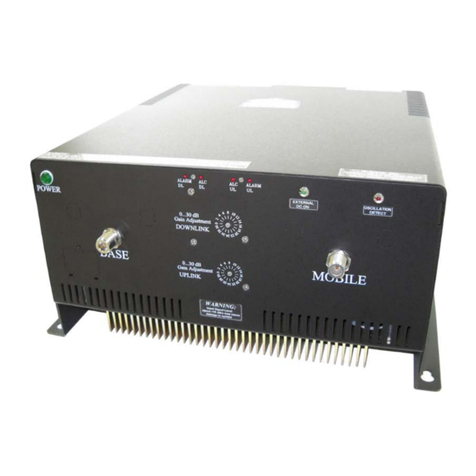
G-Wave
G-Wave BDA-SMR/N-37 Installation and operating manual
NXP Semiconductors
NXP Semiconductors BGD814 datasheet
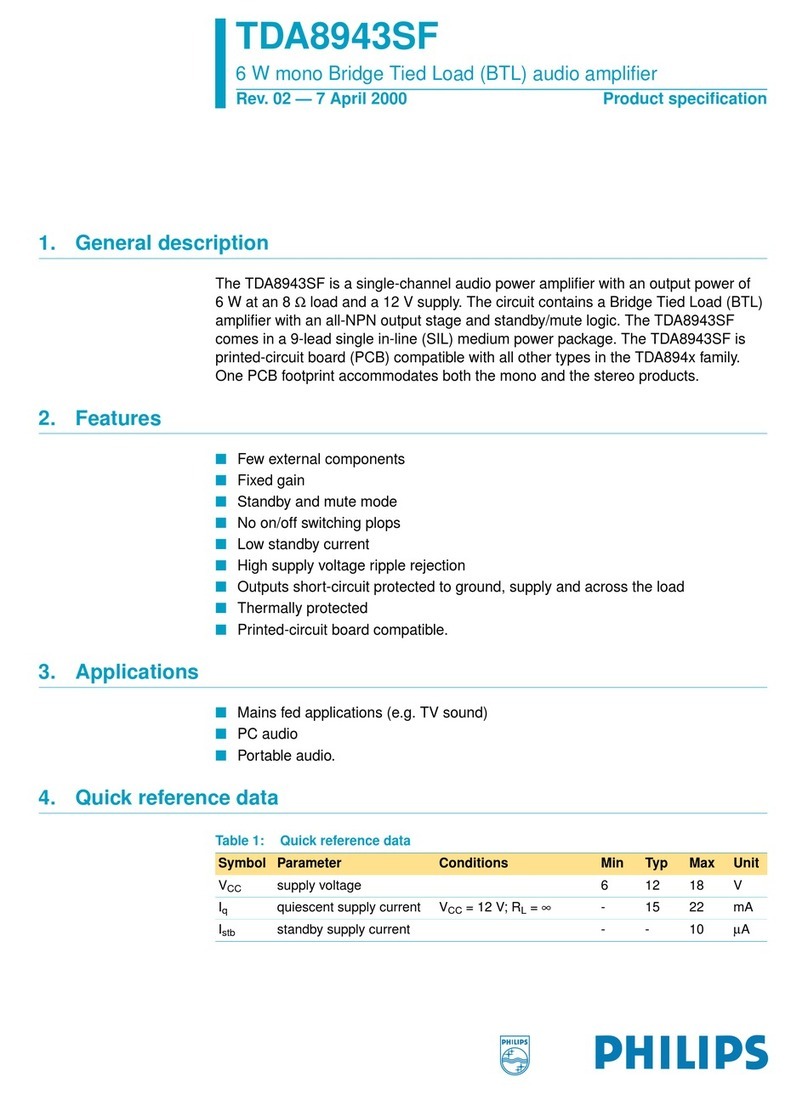
Philips
Philips TDA8943SF datasheet
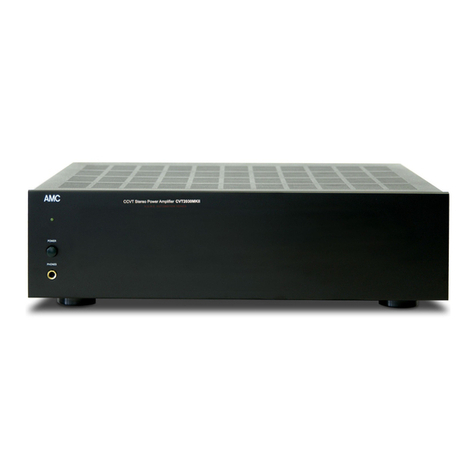
AMC
AMC CVT2030MKII Instructions for installation & operation

Avocent
Avocent Emerge DA1200D DVI-D Technical specifications
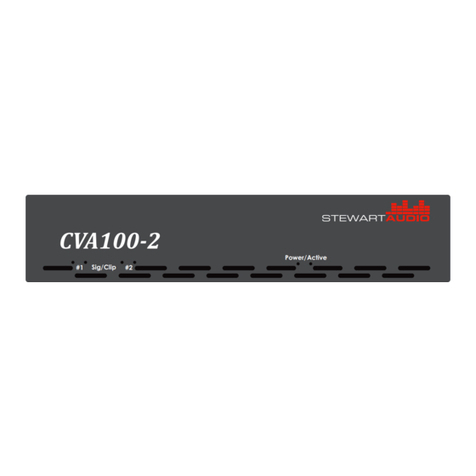
Stewart Audio
Stewart Audio CVA 100-2 owner's manual


